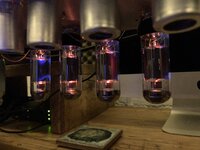H
Hexjibber
New member
Hi,
New forum user here, wondering if anyone may be able to help with some biasing strangeness that seems to be happening with my VH-2.
My set up is amp -> Suhr Reactive Load IR. I noticed that one tube was red plating so did the usual checks such as swapping tube positions around but the issue remained with that position (2nd tube from the left looking at the front of the amp). Decided at that point to buy a new matched quad (from Watford Valves) to see if that solved the issue which it seemed to initially but before long I had the same tube red plating again.
At that point I took it to my local tech to have a look but despite a few days of trying, he couldn't replicate the issue. Obviously this would seem to indicate an issue with my set up at home but I have several other amps that I use and they are all operating as expected. I took the amp home and as soon as I plugged it in, the same tube is red plating. I measured the bias using the measuring points shown on the amp PCB and sure enough that tube was reading ~60mV, where all the others were reading at ~35mV as per spec. Just out of interest I put one of the older tubes in that position and it read around ~35mV which I think was just dumb luck that the old tube was in that range. The amp seems to be working correctly from a sound point of view but even though now the tubes are all within 1-3mV of each other, that problem position tube and the one to the left of it now have a noticeable blue glow and the problem position has slight red plating, where the other pair doesn't. I feel like there is some issue here that I'm missing but haven't managed to nail it down yet.
The only thing I have tried to do is measure the resistance of a few components around the tubes and the other thing somewhat out of the ordinary was that the 1k 5W resistor near the problem tube socket read at around 900 Ohm whereas the other three were all pretty much at 1k. I realise there is component tolerance to account for etc but could this resistor be causing a bias issue?
Any help or advice would be greatly appreciated, thanks!
Graham
New forum user here, wondering if anyone may be able to help with some biasing strangeness that seems to be happening with my VH-2.
My set up is amp -> Suhr Reactive Load IR. I noticed that one tube was red plating so did the usual checks such as swapping tube positions around but the issue remained with that position (2nd tube from the left looking at the front of the amp). Decided at that point to buy a new matched quad (from Watford Valves) to see if that solved the issue which it seemed to initially but before long I had the same tube red plating again.
At that point I took it to my local tech to have a look but despite a few days of trying, he couldn't replicate the issue. Obviously this would seem to indicate an issue with my set up at home but I have several other amps that I use and they are all operating as expected. I took the amp home and as soon as I plugged it in, the same tube is red plating. I measured the bias using the measuring points shown on the amp PCB and sure enough that tube was reading ~60mV, where all the others were reading at ~35mV as per spec. Just out of interest I put one of the older tubes in that position and it read around ~35mV which I think was just dumb luck that the old tube was in that range. The amp seems to be working correctly from a sound point of view but even though now the tubes are all within 1-3mV of each other, that problem position tube and the one to the left of it now have a noticeable blue glow and the problem position has slight red plating, where the other pair doesn't. I feel like there is some issue here that I'm missing but haven't managed to nail it down yet.
The only thing I have tried to do is measure the resistance of a few components around the tubes and the other thing somewhat out of the ordinary was that the 1k 5W resistor near the problem tube socket read at around 900 Ohm whereas the other three were all pretty much at 1k. I realise there is component tolerance to account for etc but could this resistor be causing a bias issue?
Any help or advice would be greatly appreciated, thanks!
Graham

